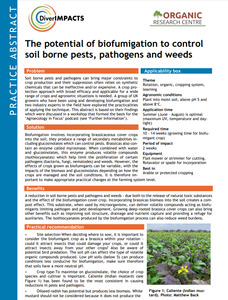{Tool} The potential of biofumigation to control soil borne pests, pathogens and weeds (DiverIMPACTS Practice Abstract). [Das Potenzial der Biofumigation zur Bekämpfung von bodenbürtigen Schädlingen, Krankheitserregern und Unkräutern (DiverIMPACTS Practice Abstract).] Creator(s): Caldbeck, Janie; Bickler, Charlotte and Bliss, Katie. Issuing Organisation(s): ORC - Organic Research Centre. (2022)
![[thumbnail of 2022-09-15 14_29_39-Protokoll.png]](/44471/1.hassmallThumbnailVersion/2022-09-15%2014_29_39-Protokoll.png)  Preview |
Image (PNG)
- Cover Image
- English
222kB |
|
PDF
- Published Version
- English
262kB |
Document available online at: https://zenodo.org/record/6771220#.YyMZXXZByUk
Summary in the original language of the document
A reduction in soil borne pests and pathogens and weeds - due both to the release of natural toxic substances and the effect of the biofumigation cover crop. Incorporating brassicas biomass into the soil creates a compost effect. This substrate, when used by microorganisms, can deliver volatile compounds acting as biofumigants limiting pathogen and pest development. Growing deep-rooted brassica cover crops can also bring other benefits such as improving soil structure, drainage and nutrient capture and providing a refuge for auxiliaries. The isothiocyanates produced by the biofumigation process can also reduce weed burdens.
Summary translation
Verringerung des Auftretens von Schädlingen, Krankheitserregern und Unkräutern im Boden - sowohl durch die Freisetzung natürlicher Giftstoffe als auch durch die Wirkung der Biofumigation-Deckfrucht. Durch die Einarbeitung der Biomasse von Brassicas in den Boden entsteht ein Kompost-Effekt. Dieses Substrat kann, wenn es von Mikroorganismen genutzt wird, flüchtige Verbindungen freisetzen, die als Biofumigants wirken und die Entwicklung von Krankheitserregern und Schädlingen einschränken. Der Anbau von tief wurzelnden Brassica-Deckfrüchten kann auch andere Vorteile mit sich bringen, wie z. B. die Verbesserung der Bodenstruktur, der Drainage und der Nährstoffaufnahme sowie die Bereitstellung eines Unterschlupfs für Hilfsstoffe. Die bei der Biofumigation entstehenden Isothiocyanate können auch die Unkrautbelastung verringern.
| EPrint Type: | Practice tool |
|---|---|
| Teaser: | Learn about the benefits of growing deep-rooted brassica cover crops and get practical recommendations. |
| What problem does the tool address?: | Soil-borne pests and pathogens can bring major constraints to crop production and their suppression often relies on synthetic chemicals that can be ineffective and/or expensive. A crop protection approach with broad efficacy and applicability for a wide range of crops and agronomic situations is needed. A group of UK growers who have been using and developing biofumigation and two industry experts in the field have explored the practicalities of applying the technique. This abstract is based on their findings which were discussed in a workshop that formed the basis for the ‘Agroecology in Focus’ podcast (see ‘Further Information’). |
| What solution does the tool offer?: | Biofumigation involves incorporating brassicaceous cover crops into the soil; they produce a range of secondary metabolites including glucosinolates which can control pests. Brassicas also contain an enzyme called myrosinase. When combined with water and glucosinolates, this enzyme produces volatile compounds (isothiocyanates) which help limit the proliferation of certain pathogens (bacteria, fungi, nematodes) and weeds. However, the effects of crops grown as biofumigants can be variable, with the impacts of the biomass and glucosinolates depending on how the crops are managed and the soil conditions. It is therefore important to make appropriate practical changes at the farming system level. |
| Country: | United Kingdom of Great Britain and Northern Ireland |
| Type of Practice Tool: | Practice abstracts |
| Keywords: | crop rotation, biofumigation, brassica, pest control, weed control |
| Agrovoc keywords: | Language Value URI English crop rotation http://aims.fao.org/aos/agrovoc/c_6662 English soil management http://aims.fao.org/aos/agrovoc/c_7176 English pest control http://aims.fao.org/aos/agrovoc/c_5726 English weed control http://aims.fao.org/aos/agrovoc/c_8345 |
| Subjects: | Soil > Soil quality Crop husbandry > Crop combinations and interactions Soil > Soil quality > Soil biology Crop husbandry > Crop health, quality, protection |
| Research affiliation: | European Union > Horizon 2020 > Diverimpacts UK > Organic Research Centre (ORC) European Union > Organic Farm Knowledge |
| Horizon Europe or H2020 Grant Agreement Number: | 727482 |
| Related Links: | https://organic-farmknowledge.org/tool/44471, https://organic-farmknowledge.org/tool/43489, https://organic-farmknowledge.org/tool/43488, https://twitter.com/farm_knowledge/status/1650483435482361856, https://www.facebook.com/organicfarmknowledge/posts/pfbid0cGyPUkrR4Hb8EtCXBgkHARTZcLMfBwbMFk2RLGM6EpD9dVfYh7myZji9noXfCSjjl |
| Project ID: | ofk |
| Deposited By: | Rüger, Madelaine Lea |
| ID Code: | 44471 |
| Deposited On: | 18 Oct 2022 07:47 |
| Last Modified: | 02 May 2024 10:31 |
| Document Language: | English |
| Status: | Published |
Repository Staff Only: item control page

 Download Statistics
Download Statistics Download Statistics
Download Statistics
